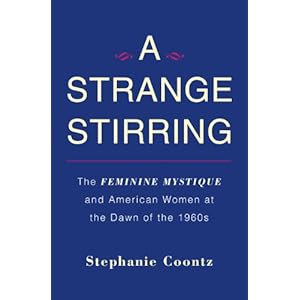 This week, Girlw/Pen writers are posting on Stephanie Coontz‘s new book, A Strange Stirring: The Feminine Mystique and American Women at the Dawn of the 1960s, which is a biography of Betty Friedan’s iconic book, The Feminine Mystique. Coontz explores the impact of Friedan’s work through archival research and interviews with nearly 200 women and men who read the book when it came out in 1963. A Strange Stirring makes the story of feminism contextual, approachable, personal…and hopeful. I’m a scholar of this area, but Coontz’s book put me in touch with The Feminine Mystique and the generation’s experience it documented, and gave me a way into conversations that I suspect will be part of the book’s impact on many people who read this accessible, compelling book.
This week, Girlw/Pen writers are posting on Stephanie Coontz‘s new book, A Strange Stirring: The Feminine Mystique and American Women at the Dawn of the 1960s, which is a biography of Betty Friedan’s iconic book, The Feminine Mystique. Coontz explores the impact of Friedan’s work through archival research and interviews with nearly 200 women and men who read the book when it came out in 1963. A Strange Stirring makes the story of feminism contextual, approachable, personal…and hopeful. I’m a scholar of this area, but Coontz’s book put me in touch with The Feminine Mystique and the generation’s experience it documented, and gave me a way into conversations that I suspect will be part of the book’s impact on many people who read this accessible, compelling book.
While reading A Strange Stirring, the people I wanted to talk to were men who were becoming adults back then. So, I asked two dear friends, one born in 1935, the other born in 1940, to tell me their experiences around the publication of Friedan’s TFM in 1963.
They read my columns at GWP, so they knew where I am coming from. They are white, college-educated, professional men who have lived comfortable though not always peaceful lives, and when The Feminine Mystique was published, each was married and raising their families of late-wave baby boomers. “Mad Men” might give you a pretty good picture of the world they lived and worked in. Indeed, every time I watch that show, I map the experience depicted there onto the way I imagine the wallpaper of these men’s minds (as well as these men’s wives.) That said, these guys were not boozing or philandering (as far as I know!), and only one of them was smoking. (And you can thank Coontz’s column for making the “Mad Men” connection so clear to me.)
What they said made me confident that the message of The Feminine Mystique was a legitimate one in its time. One of my friends said:
Looking back, I recall how different I assumed women were from men. For me, the Human Race had two types of participants: men and women. Both were members of the Race but men were the real representatives and transmitters of the Race. Women were a necessary and wonderful part of the Race but they were not “real” members (you should pardon the expression). So, I saw all women through the prism of “different,” and implicitly inferior because they were not “equal.” Women were similar but not the “same.”
My other friend put it more starkly: He said: “I was one of those arch male-chauvinist pigs that one used to hear about. When TFM first came out, I readily dismissed it in that I heard (never read it) all kinds of things — the usual anti-family etc. [claims].”
Then they described how they changed. In their recounting, their change came as a consequence of their experiences with women at work who were competent, capable, ambitious, serious-minded. Out in the world—with more and more women out there too—these two men were able to learn that women had sexual desires that were no different from what they understood “men’s desire” to be. And from what I know about my two friends, they continued to work in their professional lives from the 1970s to the present to counteract sexism in hiring, to promote women in leadership, and to mentor young women (like me!) with the same tenacity and high standards that they mentored young men.
But here’s the other piece, and it brings us back to Coontz’s book: these guys recalled the past with some regret, managing with dignity to fight against being defensive. This was a “touchy subject” they said. They “simmered” before answering my questions. I think that was because they had been contained in the same culture that Friedan’s women were. The conversation we opened moves me, and gives me hints of just how much change there has been (as Coontz writes) and also why and how after so much progress gender inequality can persist…and be so sneaky.
A Strange Stirring rightly reminds us about Friedan’s neglect of racism, economic inequality, and homophobia. Coontz writes about her skepticism at the beginning of her project about the The Feminine Mystique because of these absences: but she concludes that the work speaks to a common experience, and made a meaningful, progressive, and humane difference in the lives of many women. I would suggest also in the lives of many men.
Coontz gives us the means to recall the past with full understanding and compassion for women and for men. I think dialogues about the status of women in society and about feminism will improve, thanks to this book. Stephanie Coontz has quite a track record for doing so with her other books (such as The Way We Never Were: American Families and the Nostalgia Trap and Marriage, A History: From Obedience to Intimacy, or How Love Conquered Marriage) as well as her public education endeavors with the Council on Contemporary Families.
Stay tuned for more on Coontz and A Strange Stirring this week.


